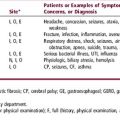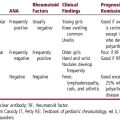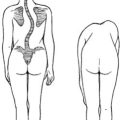Chapter 7 Evidence-Based Medicine
INTRODUCTION TO EVIDENCE-BASED MEDICINE (EBM)
What Do I Need to Know to Use EBM?
Using EBM requires that you understand the basic principles of epidemiology and biostatistics. In addition, you should have a working knowledge of the medical literature, including common study designs, and feel comfortable performing a basic MEDLINE search. Brief reviews are in the reference list (Gehlbach, 2002; Greenhalgh, 2006).
What Does “Evidence-Based Medicine” Mean?
EBM is the “conscientious, explicit, and judicious use of current best evidence in making decisions about the care of individual patients” (Sackett et al., 1996). EBM assumes that physicians whose practice is based on a solid understanding of the underlying evidence will provide superior patient care. EBM guides are available for interpreting most types of articles found in the medical literature. This chapter only discusses EBM for treatment questions, because these are most commonly encountered during the clerkship. Refer to the original JAMA series (Oxman et al., 1993) or review texts (Straus et al., 2005; Greenhalgh, 2006) for additional EBM topics.
How Does EBM Relate to My Other Studies?
You will use EBM to assist with management of a specific patient or problem. The general learning during the clerkship will still come from participating directly in patient care, from reading textbooks or quality review articles, or from online resources such as the Computer-assisted Learning in Pediatrics Project (CLIPP) (http://clippcases.org).
How Do I Use MEDLINE?
Students commonly find too many or too few articles or find articles that are not relevant. Review the basics of MEDLINE searching (Greenhalgh 1997; Greenhalgh 2006) and ask for help from a medical librarian. The following suggestions will improve your search strategy:
1 Be sure that you understand the concepts of MeSH headings and Boolean operators (“and,” “or,” and “not”).
2 Use the PICO format to focus the question and define search parameters.
3 Use the “age-limit” function appropriate to your patient.
4 Use “quality filters” to limit your search. To identify treatment articles, add “randomized controlled trial,” “clinical trial,” “meta-analysis,” and “practice guideline” to the search strategy, or use the EBM functions of Ovid and PubMed. Ask your librarian for help.
5 Read the abstracts identified by your search and choose one to three of the best articles that are relevant to your patient. Next, read each article to gain an understanding of the study’s hypothesis, methodology, and conclusions. Then, “map out” each study on paper to make the methodology and its strengths and limitations clear. This will help you determine the validity and significance of the results (Gehlbach, 2002; Greenhalgh, 2006).
How Do I Evaluate the Clinical Evidence in a Study?
Ask the following three broad questions:
The medical literature about treatment, diagnosis, and prognosis uses specific subsets of questions for each type of study to evaluate the data. The references (Oxman et al., 1993; Straus et al., 2005) provide guidance on how to appraise articles on topics other than treatment.
EVALUATING A THERAPEUTIC TRIAL
How Do I Decide if the Results Are Valid?
Were all patients accounted for and were patients analyzed in the groups to which they were randomized?
How Do I Evaluate the Results of a Therapeutic Trial?
How large was the treatment effect?
Consider a study in which death is the outcome for 20% (0.20) of patients in a control group but only 15% (0.15) of patients in a treatment group (Table 7-1). Results might be expressed in terms of absolute risk reduction or relative risk reduction.
 Absolute risk reduction (ARR) is the absolute difference between the proportion that died in the control group and the proportion that died in the treatment group. In this example, it would be 5%.
Absolute risk reduction (ARR) is the absolute difference between the proportion that died in the control group and the proportion that died in the treatment group. In this example, it would be 5%.
 Relative risk reduction (RRR) expresses the difference as a percentage and is more commonly used to express the impact of treatment. In this example, the new treatment reduced the risk of death by 25% relative to that occurring among control patients.
Relative risk reduction (RRR) expresses the difference as a percentage and is more commonly used to express the impact of treatment. In this example, the new treatment reduced the risk of death by 25% relative to that occurring among control patients.
| Measure of the Effect of Therapy | Example |
|---|---|
| Outcome without therapy (X) | 20% mortality |
| Outcome with therapy (Y) | 15% mortality |
| Absolute risk reduction (X – Y) | 20% – 15% = 5% |
| Relative risk reduction: [1 – (Y/X)] × 100% | [1 – (0.15/0.2)] × 100% = 25% |
| Number needed to treat: 1/(X – Y) | 1/0.05 = 20 |
Will the New Treatment Help My Patient(s)?
Do benefits outweigh potential harms and costs?
Benefits are best assessed using the “number needed to treat” (NNT) (Table 7-1). The NNT is determined by the question “How many patients would need to be treated in order to prevent one adverse outcome?” In the earlier example, you would have to treat 20 patients to prevent 1 death. In addition, you need to ask whether the benefits of a given therapy outweigh its adverse effects for your patient(s). For example, treatment of mild asthmatic patients with ipratropium might result in 40 patients developing significant tachycardia for every life saved, whereas treatment of only severe asthmatics might result in 4 patients with significant tachycardia for every life saved. You need to consider your patient’s asthma and clinical status before deciding to use ipratropium for the next asthma exacerbation.
PRESENTING THE EVIDENCE
What Guidelines Should I Use for an EBM Report?
In general, a written presentation should be between one and three pages and a verbal presentation between 5 and 10 minutes. The following format, adapted from Patient-Oriented Evidence that Matters (POEMS), is appropriate for written and verbal reports (Slawson et al., 1997):
1 Introduction: State the clinical question, and give the references for the article(s) that you evaluated. Briefly describe your search strategy.
2 Background: Why did you ask this question? What population of patients are you interested in? How does the question fit into the larger context of pediatric practice?
3 Study design: Briefly describe the study’s methodology (the “map”). Report the inclusion and exclusion criteria and whether the study results were statistically significant. Comment on the strengths and weaknesses of the study design and conclusions, but do not be overly critical.
4 Answer the three core EBM questions:
5 Recommendations for clinical practice: This is the most important part of the critical appraisal exercise. Make recommendations for the patient in question (and similar patients) based on what you have learned. Do not be afraid to state the conclusions from your review of the evidence, but be prepared to support them.
Can I Find Online EBM Resources?
 Online tutorials teach the fundamental concepts of EBM. Look first for tutorials or links on a medical library Web site. A user-friendly online EBM tutorial co-developed by Duke University and the University of North Carolina–Chapel Hill can be found at www.hsl.unc.edu/services/tutorials/ebm/index.htm
Online tutorials teach the fundamental concepts of EBM. Look first for tutorials or links on a medical library Web site. A user-friendly online EBM tutorial co-developed by Duke University and the University of North Carolina–Chapel Hill can be found at www.hsl.unc.edu/services/tutorials/ebm/index.htm
 Collections of evidence-based reviews, meta-analyses, and practice guidelines for common clinical problems may be linked on the medical library Web site. Ask the librarian.
Collections of evidence-based reviews, meta-analyses, and practice guidelines for common clinical problems may be linked on the medical library Web site. Ask the librarian.
Gehlbach SH. Interpreting the medical literature, ed 4. New York: McGraw-Hill, 2002.
Greenhalgh T. The MEDLINE database. BMJ. 1997;315:180.
Greenhalgh T. How to read a paper: the basics of evidence-based medicine, ed 3. Malden, MA: Blackwell Publishing, 2006.
Oxman AD, et al. Users’ guides to the medical literature: I. How to get started. JAMA. 1993;270:2093.
Sackett DL, et al. Evidence-based medicine: What it is and what it isn’t. BMJ. 1996;312:71-72.
Slawson DC, et al. Mastering medical information and the role of POEMS—patient-oriented evidence that matters. J Family Pract. 1997;45:195.
Straus SE, Richardson WS, Glasziou P, Haynes RB. Evidence-based medicine: how to practice and teach EBM, ed 3. Edinburgh: Churchill Livingstone, 2005.



















